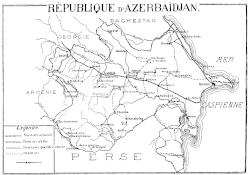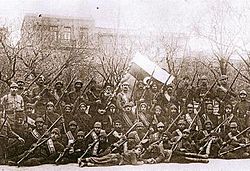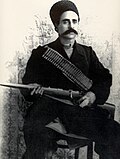Azerbaijani people
The Azerbaijanis, or Iranian Azeri (Azerbaijani: Azərbaycanlılar) are a Turkic people living mainly in the Republic of Azerbaijan and Iranian Azerbaijan. A small minority live in southern Dagestan in Russia.
| Total population | |
|---|---|
| approx. 30 million[1][2]https://upload.wikimedia.org/wikipedia/commons/d/df/Azerbaijani_diaspora_map.png | |
| Regions with significant populations | |
| 15 to 20 million[3]: Script error: The function "hyphen2dash" does not exist. [4][5][6][7][8][9] | |
| 621,800 to 1,500,000[10][11] | |
| 530,000 to 2,500,000[11] | |
| 284,761 to 500,000[11][12] | |
| 78,295[13] | |
| 45,176[14] | |
| 44,400[15] | |
| 33,365[16] | |
| 18,000[17] | |
| 17,823[18] | |
| 15,219 | |
| 15,000[19] | |
| 6,362[20] | |
| 5,553[21] | |
| 3,465[22] | |
| 1,697[23] | |
| 1,000[24] | |
| 880[25] | |
| 788[13] | |
| Languages | |
| Azerbaijani | |
| Religion | |
| Islam (historically Shia Islam) | |
| Related ethnic groups | |
| Other Turkic peoples (especially Turkmens and Turks) | |
After the Russo-Persian War (1804–1813) and Russo-Persian War (1826–1828), the land of the Iranian Qajar dynasty in the Caucasus were given to the Russian Empire which makes up the present territory of the Republic of Azerbaijan. Lands which Iran kept are now known as Iranian Azerbaijan. Even though they live on two sides of an international border, the Azerbaijanis are a single ethnic group.[26] However, northerners and southerners differ due to nearly two centuries of separate social evolution of Iranian Azerbaijanis and Russian/Soviet-influenced Azerbaijan. The Azerbaijani language unifies Azerbaijanis, and is mutually intelligible with Turkmen, Qashqai, Gagauz, Turkish, and the dialects spoken by the Iraqi Turkmen, all of which belong to the Oghuz, or Western, group of Turkic languages.[27]: Script error: The function "hyphen2dash" does not exist.  The Azerbaijanis are mostly Shia Muslim.[28][26]
Azerbaijani People Media
Territorial extent of the Seljuk Empire in 1090, stretching from Karakum Desert to modern-day Azerbaijan
"Young noble Tatar," by Vasily Vereshchagin. Shusha, 1865
Map of Azerbaijan Democratic Republic presented by the Azerbaijani delegation Paris Peace Conference in 1919
Soldiers and officers of the army of Azerbaijan Democratic Republic in 1918
Sattar Khan (1868–1914) was a major revolutionary figure in the late Qajar period in Iran
Toghrul III (center), last ruler of the Seljuks, an empire founded by Oghuz Turks of the Seljuk Oghuz clan
Azerbaijani girl from Shusha in silk national garments
Related pages
Other websites
- Azerbaijan -Citizendium
References
- ↑ "Azerbaijani". Joshua Project. Retrieved 24 January 2012.
- ↑ Sela, Avraham (2002). The Continuum Political Encyclopedia of the Middle East. Continuum. p. 197. ISBN 0-8264-1413-3.
30–35 million
- ↑ Cite error: Invalid
<ref>tag; no text was provided for refs namedLibrary of Congress Iran. - ↑ Minahan, James (2002). Encyclopedia of the Stateless Nations: S-Z. Greenwood Publishing Group. p. 1765. ISBN 978-0-313-32384-3.
Approximately (2002e) 18,500,000 Southern Azerbaijanis in Iran, concentrated in the northwestern provinces of East and West Azerbaijan. It is difficult to determine the exact number of Southern Azeris in Iran, as official statistics are not published detailing Iran's ethnic structure. Estimates of the Southern Azerbaijani population range from as low as 12 million up to 20% of the population of Iran – that is, nearly 27 million.
- ↑ Shaffer, Brenda (2003). Borders and Brethren: Iran and the Challenge of Azerbaijani Identity. MIT Press. pp. 221–225. ISBN 0-262-19477-5.
There is considerable lack of consensus regarding the number of Azerbaijanis in Iran ... Azerbaijani student groups in Iran claim that there are 27 million Azerbaijanis residing in Iran.
- ↑ Olson, Robert W. (2004). Turkey-Iran relations, 1979–2004: revolution, ideology, war, coups and geopolitics. Mazda. p. 76. ISBN 1-56859-114-4.
... in Ankara, Johragani denounced 'Persian' chauvinism and Iran's violation of human rights against the '20 million Azeris of Iran'.
- ↑ Brown, E. K.; Asher, R. E.; Simpson, J. M. Y. (2006). Encyclopedia of Language & Linguistics, Volume 1 (2 ed.). Elsevier. p. 635. ISBN 0-08-044299-4.
Azerbaijani speakers in Iran are more numerous than those in Azerbaijan (13 to 30 million in northern Iran, 6 million in the Republic of Azerbaijan).
{{cite book}}: CS1 maint: multiple names: authors list (link) - ↑ Alieva, Leila (2007). "Promoting Cooperation and Integration in the Wider Black Sea Area". In Volten, Peter M. E.; Tashev, Blagovest (ed.). Establishing security and stability in the wider Black Sea area: international politics and the new and emerging democracies. NATO Science for Peace and Security, Volume 26: Human and societal dynamics. IOS Press. p. 157. ISBN 978-1-58603-765-9.
... large number of Azerbaijanis (30 million in northern Iran and 8 million in present Azerbaijan), ...
{{cite book}}: CS1 maint: multiple names: editors list (link) - ↑ Stokes, Jamie; Gorman, Anthony (2008). Encyclopedia of the Peoples of Africa and the Middle East, Volume 1. Infobase. p. 79. ISBN 978-1-4381-2676-0.
... 32 million people in Iran...
{{cite book}}: CS1 maint: uses authors parameter (link) - ↑ "Итоги переписи". 2002 census. Russian Federation State Statistics Service. 2004. Archived from the original on 2 February 2008. Retrieved 17 January 2012.
- ↑ 11.0 11.1 11.2 van der Leeuw, Charles (2000). Azerbaijan: a quest for identity : a short history. Palgrave Macmillan. p. 19. ISBN 978-0-312-21903-1.
- ↑ "Ethnic groups by major administrative-territorial units" (PDF). 2002 census. National Statistics Office of Georgia. Archived from the original (PDF) on 4 October 2018. Retrieved 17 January 2012.
- ↑ 13.0 13.1 "Population by national and/or ethnic group, sex and urban/rural residence". United Nations Statistics Division. Retrieved 17 January 2012.
- ↑ "About number and composition population of Ukraine by data All-Ukrainian census of the population 2001". Ukraine Census 2001. State Statistics Committee of Ukraine. Retrieved 17 January 2012.
- ↑ "The National Structure of the Republic of Uzbekistan". Umid World. 1989. Archived from the original on 23 February 2012. Retrieved 17 January 2012.
- ↑ "Всесоюзная перепись населения 1989 года. Национальный состав населения по республикам СССР". Демоскоп Weekly (in русский). 1–22 January 2012. Retrieved 17 January 2012.
- ↑ "The Kingdom of the Netherlands: Bilateral relations: Diaspora" (PDF). Republic of Azerbaijan Ministry of Foreign Affairs. Archived from the original (PDF) on 6 July 2011. Retrieved 17 January 2012.
- ↑ "5.01.00.03 Национальный состав населения" (PDF) (in русский). National Statistical Committee of Kyrgyz Republic. 2011. Archived from the original (PDF) on 13 November 2013. Retrieved 17 January 2012.
- ↑ Oguz-Gassanly, Murad (2001). "Azeri Diaspora. The Case of the United Kingdom". Azeri Voice. Archived from the original on 2 May 2014. Retrieved 17 January 2012.
- ↑ "Population Census 1999". National Statistical Committee of the Republic of Belarus. Archived from the original on 26 May 2012. Retrieved 18 January 2012.
- ↑ "First, Second, and Total Responses to the Ancestry Question by Detailed Ancestry Code: 2000". U.S. Census Bureau. Retrieved 18 January 2012. This number includes both primary and secondary ancestry.
- ↑ "Ethnic origins, 2006 counts, for Canada, provinces and territories – 20% sample data". Statistics Canada. 10 June 2010. Archived from the original on 11 December 2020. Retrieved 18 January 2012. In the 2006 census, 1,480 people indicated 'Azerbaijani' as a single response and 1,985 as part of multiple origins.
- ↑ Poleshchuk, Vadim (March 2001). "Accession to the European Union and National Integration in Estonia and Latvia" (PDF). European Center for Minority Issues. Archived from the original (PDF) on 2 March 2011. Retrieved 18 January 2012.
232 citizens
- ↑ "The Republic of Austria: Bilateral relations" (PDF). Republic of Azerbaijan Ministry of Foreign Affairs. Archived from the original (PDF) on 8 March 2020. Retrieved 18 January 2012.
- ↑ "Population Census of 2000". Statistics Estonia. Retrieved 19 January 2012. Select "Azerbaijani" under "Ethnic nationality".
- ↑ 26.0 26.1 "Azerbaijani (people)". Encyclopædia Britannica. Retrieved 24 January 2012.
- ↑ Nichol, James (1995). "Azerbaijan". In Curtis, Glenn E. (ed.). Armenia, Azerbaijan, and Georgia. Federal Research Division, Library of Congress. ISBN 0-8444-0848-4.
- ↑ Robertson, Lawrence R. (2002). Russia & Eurasia Facts & Figures Annual. Academic International Press. p. 210. ISBN 0-87569-199-4.









